Things To Do
A few links and snippets of info for people who may be thinking of coming out to Italy in July for our wedding.
Sorrento
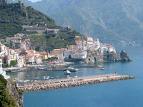
The following website is a good place to start:
www.sorrentoweb.com/uk/ptasso/index.htm
There are some useful links on the site for planning your time around Sorrento. Tourist attractions in Sorrento:
http://www.sorrentoweb.com/uk/placestovisit/index.htm
Links to railway timetables and fares, the motorway network, bus connections from Sorrento, ferry boat timetables from Sorrento, weather forecasts etc:
http://www.sorrentoweb.com/uk/information/index.htm
As an alternative, http://www.sorrentotourism.com/eng/index.html is another good website to have a look around.
Another good place to get a good impression: http://www.timesonline.co.uk/tol/travel/destinations/italy/article523141.ece
Overview

Sorrento is a bright, lively place that retains its southern Italian roots. Cheap restaurants aren't hard to find, nor is reasonably priced accommodation; and there's really no better place outside Naples itself from which to explore the rugged peninsula (even parts of the Amalfi coast) and the islands of the bay.

Sorrento's centre is Piazza Tasso, built astride the gorge that runs through the centre of town; it was named after the wayward sixteenth-century Italian poet to whom the town was home and has a statue of him in the far corner. It's nice to wander through the streets of Sorrento that feed into the square, some of which are pedestrianized for the lively evening passeggiata. The local Museo Correale di Terranova, housed in the airy former palace of a family of local counts at the far end of Via Correale (Mon & Wed–Sun 9am–2pm; €6), takes up an hour or so and houses various paintings of the Neapolitan school, the odd foreign canvas, including an obscure Rubens, lots of views of Sorrento and the Bay of Naples, and various locally unearthed archeological knick-knacks. It's nice to linger in the shady gardens of the Villa Comunale, whose terrace has lovely views out to sea, and peek into the small thirteenth-century cloister of the church of San Francesco just outside, planted with vines and bright bougainvillea – a peaceful escape from the bustle of the rest of Sorrento.

If you don't fancy the crowds in Sorrento, you can try the beaches further west. Twenty minutes' walk from the centre of Sorrento along Via del Capo, or a short bus ride from Piazza Tasso, there are a couple of options. You can either walk ten minutes or so from the bus stop down the Ruderi Villa Romana Pollio to some nice rocks, swathed with walkways, around the ruins of a Roman villa; or you could stroll 100m further west and take a path off to the right past the Hotel Dania, which shortcuts in ten minutes or so to Marina Puolo – a short stretch of beach lined by fishing boats and a handful of trattorias.
Transport
Trains
There is a local train, the Circumvesuviana, that runs from Sorrento to Naples making many stops along the way. It is about 90 minutes from Sorrento to Naples and also stops at Pompeii and Herculaneum (see below).
Buses
Buses run from Sorrento to all points on the Peninsula and the Amalfi coast but by most accounts can be a bit of a cramped ride.
Ferries
A hydrofoil ferry service runs from Sorrento to several points:
- Sorrento to Capri, every 30 minutes in the morning and evening, once an hour mid-day
- Sorrento to Naples, every two hours or so
- Sorrento to Ischia, one direct run in the morning, returning late afternoon
- Sorrento to Amalfi, once a day direct at odd times
- Sorrento to Positano, twice a day direct at odd times
Driving
Hiring a car seems a popular option although it’s worth noting that the Amalfi Coast drive has amazing views but the road is very narrow and goes directly through many small towns, so you have to drive very carefully as it becomes particularly chaotic. There seems to be a lot of traffic with some of the faster cars overtaking pretty dangerously. By most accounts, the drive from Sorrento to Positano seems a far more pleasant drive than from Postiano to Amalfi.
Approximate Driving Times:
- Ravello to Amalfi - 15 minutes
- Amalfi to Positano - 30 minutes
- Positano to Sorrento – 30-45 minutes (depending on traffic)
Pompeii, Herculaneum & Mount Vesuvius
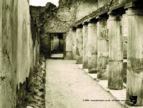

Pompeii, the most famous archaeological site in Italy, is easy to get to from Sorrento either on an organised excursion or by just jumping on the train. Making your own way there seems to be the better option as you are not limited by time constrictions looking around. The excavations are visited by millions of visitors every year and offer one of the most important pieces of evidence of the past in the world. Life in this rich and prosperous city was dramatically and brusquely interrupted in 79 C.E. when Mount Vesuvius erupted and totally buried it. The city and its inhabitants were wiped out in moments. A visit to the excavations gives you a pretty good idea of what life must have been like here two thousand years ago.

Herculaneum can be combined with Pompeii for an excellent day-trip. It was a smaller town than Pompeii, with fewer and more wealthy residents. Buildings in Herculaeum are very well-preserved, and there are many samples of preserved organic materials including wood, rope and cloth. Upon entering the site you descend down and around the city, offering an exceptional birds-eye view of the site.
To reach Herculaneum, take the Circumvesuviana train to the stop called Ercolano. Trains leave Sorrento every thirty minutes.
Opening times: April - October- every day from 8.30 am. to 7.30 pm (last admission 6 p.m.)

Mount Vesuvius is always visible from Sorrento and Pompeii and is well worth visiting if for no other reason than to say you have stood looking into an active volcano. Mount Vesuvius is best known for its eruption in AD 79 that led to the destruction of the Roman cities of Pompeii and Herculaneum. It has erupted many times since and is today regarded as one of the most dangerous volcanoes in the world because of the population of 3,000,000 people now living close to it and its tendency towards explosive eruptions. It is the most densely populated volcanic region in the world.
From Ercolano, you can get the bus to the base station of Vesuvius. The walk to the top of the crater from there takes about an hour. The Circumvesuviana train costs about 4€, entry to Pompeii 11€. The Ercolano - Vesuvius bus as well as entry to Vesuvius itself are apparently pretty cheap too. There are plenty of options to get there.
Capri
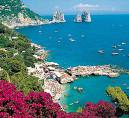


This is one of the most famous and celebrated Italian islands in the world, noted for its extraordinary natural beauty, its splendid panorama, its azure grotto and its mild climate. Capri is without doubt one of the most sought after destinations among the international jet-set. Rich in history, the island welcomes to its famous Piazzetta Umberto I, those who love luxury and a worldly lifestyle, and has a first rate range of hotels, all of them luxurious and immersed in enchanting scenery, there are also many restaurants offering Mediterranean cuisine. The island is a short sail from Sorrento with regular departures. It’s busy but worth the jostle. After the harbour sights, you can take the funicular railway up to the main town and from there follow the signs for Villa Jovis - about a 2 hour walk to fantastic views of the villa remains. You can also take the local bus up to the picturesque village of Ana Capri. It may also be worth a visit to the two other islands nearby – Ischia and Procida – which are less crowded but equally breathtaking.
Amalfi Coast Tour
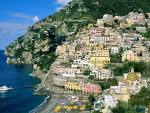

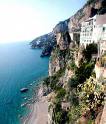
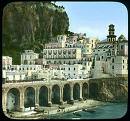
Experience the lifestyle and history of Naples and the Amalfi coast with a tour of the surrounding area. Starting in either Naples or Sorrento, there are plenty of tour options available by doing a Google search - you can explore Mt. Vesuvius and the incredibly preserved city of Herculaneum. Then, enjoy the relaxing nature of the island of Ischia while sipping on limoncello, the local liquor. Take in the amazing views in Ravello, and swim in the balmy blue waters off the exclusive island of Capri. Keep in mind that official tours can be pretty pricey, so a better option to explore the coast might be to hire a car or do it by public transport. The ‘hop-on, hop-off’ bus tour of the Sorrento headland comes well recommended. Have a look at their website: http://www.sorrento.city-sightseeing.it/eng/index.htm
Places to visit in and around Naples
Museo Nazionale di Capodimonte
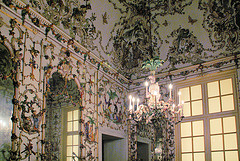


The Reggia di Capodimonte building, destined to house porcelain production, was constructed in the large grounds by Ferdinando Fuga in 1743. The porcelain drawing room belonging to Queen Amalia of Saxony was established in 1759. Today, the numerous rooms display collections of porcelain and china from the Real Fabbrica di Capodimonte, collections of coins and weapons, medieval armor, and Flemish tapestries. The Picture Gallery includes works by the best known painters from Naples, Italy and abroad - Masaccio, Simone Martini, Masolino, Botticelli, Raffaello, Bellini, Tiziano, Caravaggio, Reni, Schedoni, Cavallino, Preti, Giordano, Witz, Breughel, El Greco, and Goya. Admission: EUR 7.50.
Galleria Principe di Napoli

Designed in 1869 by architects Nicola Breglia and Giovanni De Novellis, this ornate shopping gallery filled with stylish boutiques was built between 1876 and 1883 as part of planned improvements to Via Fosse del Grano. The cast-iron and glass roof and solid masonry of the walls graced with splendid stucco decorations are a masterful combination of modern and traditional construction techniques. The gallery opens out onto Via Pessina, Via Broggia and the square in front of the National Museum.
Vulcano Solfatara
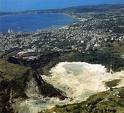
Solfatara is a dormant volcano belonging to the volcanic area of the Campi Flegrei, believed by the ancients to be the entrance to the regions of Hell. It is noteworthy today on account of the explosions of sulphuric gases, at temperatures well over 160° C, as well as for the anhydrous carbon vapours and the smaller eruptions of boiling mud. During the nineteenth century it was a renowned spa, on account of its waters, natural saunas and hot mud; sulphur compounds were also extracted...
Castel dell'Ovo
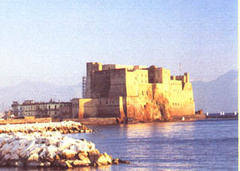
First settled by the ancient Greeks who went on to found the city of Partenope, the tiny island of Megaride is home to the city's oldest castle. Many believe the name, Castel dell'Ovo, is due to its unusual shape (ovo meaning "egg"); however, others maintain that the name is linked to medieval legend. Apparently the poet Virgil hid an egg in an iron cage and left it to hang from a rafter in a secret place within the castle; if the egg is broken, both the castle and the city are doomed to destruction.
Lungomare (Il)

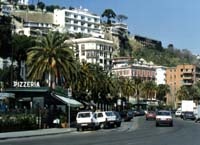
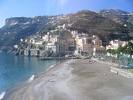
Once a quiet fishing village, today this pleasant walk along the seashore is one of the city's liveliest districts, filled with luxury hotels and exclusive restaurants. A stroll along Via Nazario Sauro, Via Partenope and Via Caracciolo takes you to the moorings where local fishing boats are transformed each morning into small floating markets selling freshly landed fish. Crystal clear water flows from the Leone fountain and in beautiful Piazza Sannazzaro, the Sirena fountain is a reminder of mythical siren Partenope, whose tomb, according to local legend, marks the site on which Naples was founded.
Campi Flegrei - Cuma



Cuma is the oldest of Magna Grecia's Hellenic colonies. It is the farthest from the mother country and is where the mythical Sibyl was consulted by Aeneas when he was fleeing Troy. Cuma was founded in 740 BC, and the diffusion of the Greek alphabet in the Western Mediterranean is all due to this city. Cuma's unstoppable decline began under Roman rule and it was abbandoned in the Middle Ages after the Saracen invasions. The ancient Greek city stood on the promontory which now contains the beautiful archeological site which offers visitors the chance to see such mythical sites such as the extraordinary cave of the Sibyl: a long tunnel carved into the tufa which ends in a rectangular room where the Sibyl prophesied. Following the paved road which leads up the hill towards the acropolis, you will come across the remains of the Temple of Apollo and Jove, and not far away is the Roman Arco Felice which dominates a section of the ancient Via Domiziana which linked Pozzuoli with Rome.